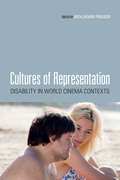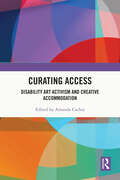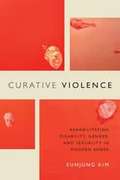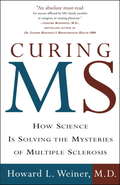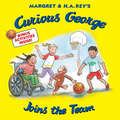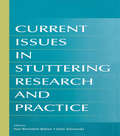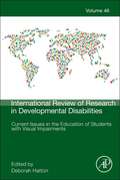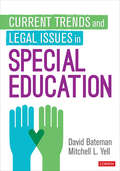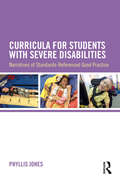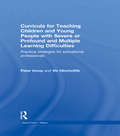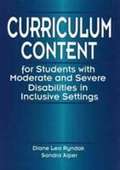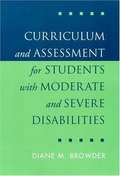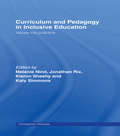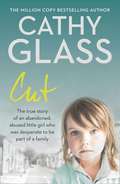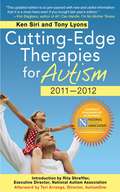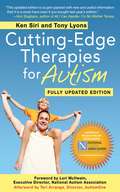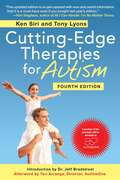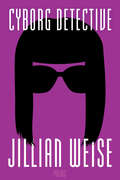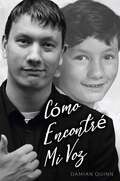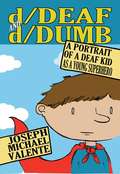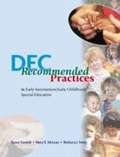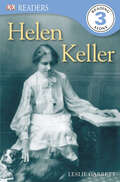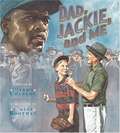- Table View
- List View
Cultures of Representation: Disability in World Cinema Contexts (Toronto Iberic Ser.)
by Benjamin FraserCultures of Representation is the first book to explore the cinematic portrayal of disability in films from across the globe. Contributors explore classic and recent works from Belgium, France, Germany, India, Italy, Iran, Japan, Korea, Mexico, Netherlands, Russia, Senegal, and Spain, along with a pair of globally resonant Anglophone films. Anchored by David T. Mitchell and Sharon L. Snyder's coauthored essay on global disability-film festivals, the volume's content spans from 1950 to today, addressing socially disabling forces rendered visible in the representation of physical, developmental, cognitive, and psychiatric disabilities. Essays emphasize well-known global figures, directors, and industries – from Temple Grandin to Pedro Almodóvar, from Akira Kurosawa to Bollywood – while also shining a light on films from less frequently studied cultural locations such as those portrayed in the Iranian and Korean New Waves. Whether covering postwar Italy, postcolonial Senegal, or twenty-first century Russia, the essays in this volume will appeal to scholars, undergraduates, and general readers alike.
Curating Access: Disability Art Activism and Creative Accommodation
by Amanda CachiaThis book is an interdisciplinary collection of twenty-four essays which critically examine contemporary exhibitions and artistic practices that focus on conceptual and creative aspects of access. Oftentimes exhibitions tack on access once the artwork has already been executed and ready to be installed in the museum or gallery. But what if the artists were to ponder access as an integral and critical part of their artwork? Can access be creative and experimental? And furthermore, can the curator also fold access into their practice, while working collaboratively with artists, considering it as a theoretical and practical generative force that seeks to make an exhibition more engaging for a wider diversity of audiences? This volume includes essays by a growing number of artists, curators, and scholars who ponder these ideas of ad-hoc, experimental and underground approaches within exhibition-making and artistic practices. It considers how, through these nascent exhibition models and art practices, enhanced experiences of access in the museum can be a shared responsibility amongst museum workers, curators, and artists, in tandem with the public, so that access becomes a zone of intellectual and creative "accommodation," rather than strictly a discourse on policy. The book provides innovative case studies which provide a template for how access might be implemented by individuals, artists, curators, museum administrators and educators given the growing need to offer as many modalities of access as possible within cultural institutions. This book shows that anyone can be a curator of access and demonstrates how to approach access in a way that goes beyond protocol and policy. It will thus be of interest to students and scholars engaged in the study of museums, art history and visual culture, disability, culture, and communication.
Curative Violence: Rehabilitating Disability, Gender, and Sexuality in Modern Korea
by Eunjung KimIn Curative Violence Eunjung Kim examines what the social and material investment in curing illnesses and disabilities tells us about the relationship between disability and Korean nationalism. Kim uses the concept of curative violence to question the representation of cure as a universal good and to understand how nonmedical and medical cures come with violent effects that are not only symbolic but also physical. Writing disability theory in a transnational context, Kim tracks the shifts from the 1930s to the present in the ways that disabled bodies and narratives of cure have been represented in Korean folktales, novels, visual culture, media accounts, policies, and activism. Whether analyzing eugenics, the management of Hansen's disease, discourses on disabled people's sexuality, violence against disabled women, or rethinking the use of disabled people as a metaphor for life under Japanese colonial rule or under the U.S. military occupation, Kim shows how the possibility of life with disability that is free from violence depends on the creation of a space and time where cure is seen as a negotiation rather than a necessity.
Curing MS: How Science Is Solving the Mysteries of Multiple Sclerosis
by Howard L. WeinerWhat causes multiple sclerosis? When will there be a cure? Dr. Howard Weiner has spent nearly three decades trying to find answers to the mysteries of multiple sclerosis, an utterly confounding and debilitating disease that afflicts almost half a million Americans. Curing MS is his moving, personal account of the long-term scientific quest to pinpoint the origins of the disease and to find a breakthrough treatment for its victims. Dr. Weiner has been at the cutting edge of MS research and drug development, and he describes in clear and illuminating detail the science behind the symptoms and how new drugs may hold the key to "taming the monster." From the "Twenty-one Points" of MS--a concise breakdown of the knowns and unknowns of the disease--to stories from the frontlines of laboratories and hospitals, Curing MS offers a message of hope about new treatments and makes a powerful argument that a cure can--and will--be found.
Curious George Joins the Team (Curious George)
by H. A. ReyCurious George has a playdate at a park designed for children of all abilities, perfect for his new friend, Tina, who uses a wheelchair. While they are playing together, Tina spots some kids playing her favorite game: basketball. George jumps right into the action, but Tina is too shy to ask to join. George suspects Tina is just as good--even better--than the other kids. Can he come up with a way to show the players she's got game and help her overcome her shyness? This story celebrates how kids of all abilities can play together!
Current Issues in Stuttering Research and Practice
by Nan Bernstein Ratner John TetnowskiThis state-of-the art volume is a follow-up to the 1999 publication, Stuttering Research and Practice: Bridging the Gap, edited by Nan Ratner and E. Charles Healey. Like its predecessor, the current book is an edited collection of the presentations from the American Speech-Language-Hearing Association’s Annual Leadership Conference in Fluency and Fluency Disorders. Among the topics covered are evidence-based practice, impact of the self-help and support groups, meta-analyses of selected assessment and intervention programs, current theories of stuttering, and the predicted path of stuttering intervention in the future. The authoritative representation of contributors offers the reader the most up to date presentation of fluency issues, with a special emphasis placed on the practical clinical implications of fluency assessment, treatment, and evolving theories of the disorder. The book is written for fluency specialists and graduate students in programs of fluency disorders. It will also be valuable for the clinicians who wish to upgrade their skills in treating fluency disorders.
Current Issues in the Education of Students with Visual Impairments (International Review of Research in Developmental Disabilities, Volume #46)
by Deborah D. HattonThis edition addresses current issues in the education of students with visual impairments and includes the expanded core curriculum for students with visual impairment, assistive technology, Braille reading comprehension, communication development, orientation and mobility issues, and more.
Current Trends and Legal Issues in Special Education
by Mitchell L. Yell David F. BatemanBuilding and supporting effective special education programs School leaders and special educators are expected to be experts on all levels and types of special education law and services, types of disability, and aspects of academic and functional programming. With the increasing demands of the job and the ever-changing legal and educational climate, many administrators and teachers are overwhelmed, and few feel adequately prepared to meet the demands. Trends and Legal Issues in Special Education helps you build and support timely, legally sound, and effective special education services and programs. Readers will find: the most up-to-date information on how to effectively implement special education programs, processes, and procedures examination of a wide variety of issues, from developing and implementing individual education programs (IEPs) that confer a free appropriate public education, Section 504, least restrictive environment (LRE), and successfully collaborating with parents, to issues regarding accountability, staffing, bullying, early childhood special education, multi-tiered systems of support (MTSS), evidence-based practices, transition, discipline, and the school-to-prison pipeline extensive references and resources Written as a comprehensive reference for all who work with students with disabilities, this book offers the most up-to-date research and field-tested strategies from a range of experts that special education professionals can confidently and immediately apply.
Current Trends and Legal Issues in Special Education
by Mitchell L. Yell David F. BatemanBuilding and supporting effective special education programs School leaders and special educators are expected to be experts on all levels and types of special education law and services, types of disability, and aspects of academic and functional programming. With the increasing demands of the job and the ever-changing legal and educational climate, many administrators and teachers are overwhelmed, and few feel adequately prepared to meet the demands. Trends and Legal Issues in Special Education helps you build and support timely, legally sound, and effective special education services and programs. Readers will find: the most up-to-date information on how to effectively implement special education programs, processes, and procedures examination of a wide variety of issues, from developing and implementing individual education programs (IEPs) that confer a free appropriate public education, Section 504, least restrictive environment (LRE), and successfully collaborating with parents, to issues regarding accountability, staffing, bullying, early childhood special education, multi-tiered systems of support (MTSS), evidence-based practices, transition, discipline, and the school-to-prison pipeline extensive references and resources Written as a comprehensive reference for all who work with students with disabilities, this book offers the most up-to-date research and field-tested strategies from a range of experts that special education professionals can confidently and immediately apply.
Curricula for Students with Severe Disabilities: Narratives of Standards-Referenced Good Practice
by Phyllis JonesStudents with severe disabilities comprise 2 percent of the population of learners who are impacted by intellectual, communicative, social, emotional, physical, sensory and medical issues. Increasingly, however, teachers are required to meet the challenges of creating a pedagogical balance between an individual student's strengths, needs and preferences, and core academic curricula. The need to embrace the current initiative of curriculum state standards in the debate of curricula relevance, breadth, balance and depth for students with severe disabilities is not just timely—it contributes to the evolving debate of what constitutes an appropriate curriculum for severely disabled learners. Curricula for Students with Severe Disabilities supports the development of greater understandings of the role that state curriculum standards play in the pedagogical decision-making for students with severe intellectual disabilities. The book first discusses the nature and needs of these students, the curriculum for this group of learners and the recent contributions of state curriculum standards, before presenting narratives of real classrooms, teachers and students who have meaningfully integrated state curriculum standards at the kindergarten, elementary and high school levels.
Curricula for Teaching Children and Young People with Severe or Profound and Multiple Learning Difficulties: Practical strategies for educational professionals (nasen spotlight)
by Peter Imray Viv HinchcliffeCurricula for Teaching Children and Young People with Severe or Profound and Multiple Learning Difficulties offers a range of compelling arguments for a distinct and separate pedagogical approach to the learning needs of the most educationally challenging pupils. This book, written in accessible, common sense and non-academic language, provides an easy-to-follow alternative curriculum specifically designed to enhance and enrich the learning of children with profound and multiple learning difficulties. Chapter by chapter, guidelines and support are offered in key curriculum areas, some of which include: Cognition Language, Literacy and Communication Mathematical Physical Sensory Creative Care Play Problem solving. This highly practical resource is essential reading for any educational professional, parents, school governors, teachers, teaching assistants, therapists and indeed anyone involved with maximising the educational opportunities of those with profound learning difficulties.
Curriculum Content for Students with Moderate and Severe Disabilities in Inclusive Settings
by Diane L. Ryndak Sandra K. AlperThis book provides a complete description of a process through which collaborative education teams can identify appropriate functional and general education curriculum content for readers with moderate or severe disabilities who are included in general education settings.
Curriculum and Assessment for Students with Moderate and Severe Disabilities
by Barbara Wilson Diane M. BrowderA guide to designing and implementing personalized curricula for students with moderate to severe disabilities. The assessment model described provides a framework for pinpointing educational priorities, planning instruction in specific areas, and evaluating student progress. Strategies presented are teacher-friendly and data-based, and emphasize the values of self-determination, multicultural awareness, and educational accountability. Includes case studies, sample assessments, inventories of key skills, and descriptions of instructional resources, plus reproducible forms. Browder teaches special education at the University of North Carolina-Charlotte Annotation c. Book News, Inc., Portland, OR (booknews.com)
Curriculum and Pedagogy in Inclusive Education: Values into practice
by Jonathan Rix Katy Simmons Kieron Sheehy Melanie NindWhile activists, politicians and policy-makers grapple with the big picture, teachers and learners are making inclusion happen in their day-to-day lives. This unique text shows the importance and reality of curriculum and pedagogy in developing inclusive practice in a range of settings.Bringing together an exemplary collection of key articles, this Reader provides ways of thinking about inclusive curricula and pedagogy as starting points for possible action, as wel as:* illustrating how teachers can get education right or wrong for diverse learners depending on the pedagogical decisions they make;* discussing the role of the ordinary, special and inclusive pedagogy;* showing examples of teaching that elicits genuine participation and active learning;* providing case studies, and lessons from learners about what makes good teaching for them.Curriculum and Pedagogy in Inclusive Education will be inspirational reading for anyone with an interest in making inclusion happen.
Cut: The True Story of an Abandoned, Abused Little Girl Who Was Desperate to Be Part of a Family
by Cathy GlassDawn was the first girl Cathy Glass ever fostered. A sweet and seemingly well balanced girl, Dawn's outward appearance masked a traumatic childhood so awful, that even she could not remember it. During the first night, Cathy awoke to see Dawn looming above Cathy's baby's cot, her eyes staring and blank. She sleepwalks--which Cathy learns is often a manifestation in disturbed children. It becomes a regular and frightening occurrence, and Cathy is horrified to find Dawn lighting a match whilst mumbling "It's not my fault" in her sleep one night. Cathy discovers Dawn is playing truant from school, and struggling to make friends. More worryingly she finds her room empty one night, and her pillow covered in blood. Dawn has been self-harming in order to release the pain of her past. When Dawn attempts suicide, Cathy realises that she needs more help than she can give. Dawn's mother eventually confides in her that Dawn was sent away to relatives in Ireland between the ages of 5 and 9, and came back very disturbed. She also sheds light on the reason for Dawn's fascination with matches and Cathy's baby. *SPOILER ALERT*SPOILER INFO FOLLOWS* Eventually Dawn is placed in a psychiatric home for children, and five years later she gets in touch with Cathy. She has been reconciled with her mother and is now training to become a teacher.
Cutting-Edge Therapies for Autism 2010-2011
by Tony Lyons Teri Arranga Mark Freilich Ken SiriFor parents of children with autism, research is a full-time job. For parents with limited time, ability, or resources to do this, Ken Siri and Tony Lyons have compiled the latest in autism theory, research, and treatment. Cutting-Edge Therapies for Autism contains contributions from more than eighty experts on a variety of therapies, models, and multifaceted evaluation and treatment centers. Each contributor gives the reader a basic description of the topic, including its scientific rationale, development, risks, and benefits. Siri and Lyons include the therapies of the future, focusing on current clinical trials, ongoing research, and the researchers striving to better understand autism and find new treatments.
Cutting-Edge Therapies for Autism 2011-2012 (Cutting-edge Therapies For Autism Ser.)
by Tony Lyons Teri Arranga Ken Siri Rita ShrefflerThe parents of children with autism know that research is a full-time job. For parents with limited time, ability, or resources to do this, Ken Siri and Tony Lyons have compiled the latest in autism research and treatment. Cutting-Edge Therapies for Autism contains contributions from more than eighty experts on a variety of therapies, models, and multifaceted evaluation and treatment centers. Each contributor provides readers with an easy-to-understand description of the topic, including its scientific rationale, development, risks, and benefits. Siri and Lyons include the therapies of the future, focusing on current clinical trials, ongoing research, and the researchers who are striving to better understand autism and find new treatments. Revised and updated to reflect the new developments in the last year, the 2011-2012 edition explains possible causes of autism, including food allergies and gastrointestinal diseases in children. An extensive variety of therapies is discussed, from dietary interventions that reduce sugars and remove gluten to animal assisted therapies that place a dog or cat in the care of the autistic individual to help enhance social and developmental skills. Filled with numerous case studies and more than seventy distinct subjects, Cutting-Edge Therapies for Autism is a detailed and informative guide for anyone affected by autism.
Cutting-Edge Therapies for Autism, Fourth Edition
by Tony Lyons Teri Arranga Ken SiriThe parents of children with autism know that learning about treatments is a full-time job. For parents with limited time, ability, or resources, Ken Siri and Tony Lyons have compiled the latest in autism research and treatment. Exploring the possible causes of autism and presenting novel therapies, medications, and interventions, Cutting-Edge Therapies for Autism contains contributions from more than ninety experts on a wide variety of research findings, therapies, models, and multifaceted evaluation and treatment centers.Revised and fully updated to include the latest developments, this fourth edition includes up-to-date information on mitochondrial, antifungal, and physical therapy treatments; about speech, art, music, and sound therapies; and how diets, HANDLE, indigenous healing, and other exciting new treatments can be used to help your child. It also addresses developing technologies, like the iPad, which provides hundreds of apps that help kids with autism communicate and organize their day, and helps parents keep track of therapy schedules. Filled with case studies and research, Cutting-Edge Therapies for Autism is a detailed and informative guide for anyone affected by autism.
Cyborg Detective (American Poets Continuum #174)
by Jillian WeiseIn her third collection of poems, Jillian Weise delivers a reckoning to the ableism of the Western Canon. These poems investigate and challenge the ways that nondisabled writers have appropriated disabled bodies, from calling out William Carlos Williams to biohacking Raymond Carver’s “Cathedral” to chronicling the ongoing headlines of violence against disabled women. Part invective, part love poem, Cyborg Detective holds a magnifying glass to the marginalization and fetishization of disabled people while claiming space and pride for the people who already use technology and cybernetic implants every day.
Cómo Encontré Mi Voz
by Damian Quinn"...las palabras siempre conservarán su poder. Las palabras ofrecen los medios para encontrar el significado y, para aquellos que escuchan, el enunciado de la verdad". - V, 2005 El poder de la comunicación es fundamental; algunos dirían que una necesidad. Todos tenemos ese poder: humanos, insectos, aves, gatos, perros, etc. No importa a cual especie pertenezcamos, todos nos comunicamos. Lamentablemente, a algunas personas se les dificulta, y Damian fue una de ellas. El Trastorno del Desarrollo del Lenguaje, una discapacidad del habla y del lenguaje que padece Damian desde su nacimiento, hace que las frases sean confusas y lentas, incluso si las ideas de Damian son claras. Aquí Damian habla acerca de cómo el TDL ha impactado su vida, y como la organización benéfica Afasic ha estado ahí para ayudarle durante todo el trayecto. Damian tropezó con muchas dificultades a lo largo de su vida para lograr hablar. Cómo encontré mi voz relata el viaje de Damian, desde sus primeros años, sus dificultades para encontrar un diagnóstico y que la enfermedad fuera reconocida, hasta ser escuchado como vicepresidente de Afasic.
D/deaf And D/dumb: A Portrait Of A Deaf Kid As A Young Superhero (Disability Studies In Education Ser. #10)
by Joseph Valented/Deaf and d/Dumb chronicles the author's dumb, 'deaf kid' origins in Bayport, New York to his current life as a «young superhero» writer. Portraying the conflicting cultural worlds of hearing and Deaf, it describes his life in an in-between underworld and his identity as it alternates between being oppressed and empowered. These feelings are inescapably and forever the reality of those who live on the margins of our larger society.
DEC Recommended Practices In Early Intervention/Early Childhood Special Education
by Patricia Miller Susan Sandall Mary E. McleanOffers guidance to parents and professionals who work with children who are differently-abled and developmental delays.
DK Readers L3: Helen Keller (DK Readers Level 3)
by Leslie GarrettIn this new Level 3 Reader, the captivating story of Helen Keller unfolds. Children able to read on their own will be eager to delve in, learning more about Helen's life, from her early days as a deaf and mute infant, to those as an adult who achieved great academic success in spite of her challenges.
DK Readers L3: Helen Keller (DK Readers Level 3)
by Leslie GarrettIn this new Level 3 Reader, the captivating story of Helen Keller unfolds. Children able to read on their own will be eager to delve in, learning more about Helen's life, from her early days as a deaf and mute infant, to those as an adult who achieved great academic success in spite of her challenges.
Dad, Jackie, and Me
by Myron UhlbergJackie Robinson is the new first baseman for the Brooklyn Dodgers--and the first black player in Major League Baseball. A young boy shares the excitement of Robinson's rookie season with his deaf father. <P><P> Winner of the Schneider Family Book Award
